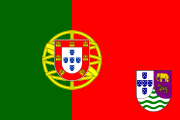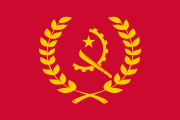Flag of Angola
This article needs additional citations for verification. (February 2011) |
 | |
| Use | National flag |
|---|---|
| Proportion | 2:3[1] |
| Adopted | 11 November 1975[2] |
| Design | Two horizontal bands of red and black with the Machete and Gear Emblem in the center. |
The national flag of Angola came into use at when Angola gained independence on November 11, 1975. It is split horizontally into an upper red half and a lower black half with an Emblem itself resting at the center. It features a yellow half gear wheel crossed by a machete and crowned with a star.
History
The Angolan flag is based on the flag of the Popular Movement for the Liberation of Angola (MPLA), which fought Portuguese colonial rule and emerged as the ruling party of Angola following the Angolan Civil War.[1] The MPLA flag is similar to the flag of Angola but features a star in place of the central emblem.[1]
Description
The National Flag of the Republic of Angola has two horizontal bands of red and black with the Machete and Gear Emblem in gold in the center consisted of a five pointed-star within a half gear wheel crossed by a machete (resembling the hammer and sickle used in the Soviet iconography).[2] As outlined in the Constitution of Angola, the red half of the flag signifies bloodshed during Angola's independence struggle, and the black half symbolizes Africa.[1] In the central emblem, the gear represents industrial workers, the machete represents peasantry and the star symbolizes socialism.[1] The flag is most recently described and explained in article 162 of the Constitutional Law of the Republic of Angola (Constitution) of August 25, 1992.
Colors
| Red | Gold | Black | |
|---|---|---|---|
| RGB | 239–42–0 | 254–254–4 | 0–0–0 |
| Hexadecimal | EF2A00 | FEFE04 | 000000 |
| CMYK | 0–82.43–100–6.27 | 0–0–98.43–0.39 | 0–0–0–100 |
2003 proposal
In 2003, a new, more "optimistic" flag was proposed by the Parliament's Constitutional Commission of the National Assembly (Angolan Parliament), but it was not adopted. The sun design in the middle is meant to be reminiscent of cave paintings found in Tchitundo-Hulu cave. The flag maintained the same flag proportions of 2:3.[3]
Gallery
-
Flag proposal for the Portuguese overseas province of Angola (1967) – never used.
-
Flag of the former movement and now governing party MPLA
-
Flag of UNITA, a rebel movement that fought against the MPLA government from 1975 to 2002
-
Proposed flag of Angola (1996)
-
Proposed flag of Angola (2003)
-
Presidential standard of Angola
References
- ^ a b c d e Flags of the world (2nd ed.). Buffalo, New York: Firefly Books. 2012 [2003]. p. 26. ISBN 978-1-77085-157-3.
- ^ a b Flags: The visual guide to more than 300 flags from around the world. New York City: Dorling Kindersley. 1998. p. 96. ISBN 0-7894-4224-8.
- ^ "Angola - proposals for a new flag". www.crwflags.com. Retrieved 2017-07-21.






